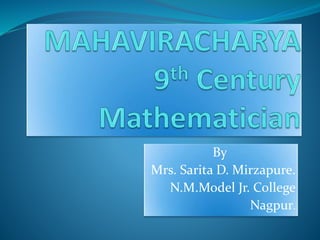
To construct a_rhombus_of_a_given_area[1]
- 1. By Mrs. Sarita D. Mirzapure. N.M.Model Jr. College Nagpur.
- 2. Mahavira Born: about 800 ad. in Mysore, India Died: about 870 in India
- 3. Mahavira was of the Jain religion and was familiar with jain mathematics. He worked in Mysore in southern India where he was a member of a School of mathematics. This great mathematician monk wrote “Ganita- Sara Samagraha” in 850 AD during the regime of the great Rashtrakuta king Amoghavarsha .
- 4. This book was designed as an updating of Bramhagupta’s book. Filliozat writes :This book deals with the teaching of Bramha-gupta but contains both simplifications and additional information..... Although like all Indian versified texts,it is extremely condensed, this work ,from a educational point of view, has a significant advantage over earlier texts.
- 5. This book consisted of nine chapters and included all mathematical knowledge of mid- ninth century India. There were many Indian mathematian during the time of Mahavira ,but their work on mathe- matics is always contained in text which discuss other topics such as Astronomy . The Ganita Sara Samgraha is the only early Indian text which is devoted entirely to mathematics .
- 6. In the introduction to the work Mahavira paid tribute to the mathematicians whose work formed the basis of his book. Mahavira writes:- With the help of accomplished holy sages, who are worthy to be worshipped by the lords of the world....I glean from the great ocean of the knowledge of numbers a little of its essence,
- 7. in the manner in which gems are picked from the sea , gold from the stony rock and the pearl from the oyster shell; and I give out according to power of my intelligence, the Sara Samgraha, a small work on arithmetic, which is however not small in importance.
- 8. The nine chapters of the Ganita Sara Samgraha are: 1. Terminology 2. Arithmetical operations 3. Operations involving fractions 4. Miscellaneous operations 5. Operations involving the rule of three 6. Mixed operations 7. Operations relating to the calculations of area 8. Operations relating to the excavations 9. Operations relating to the shadows.
- 9. Ex. on Indeterminate equation. Three merchants find a purse lying in the road. One merchant says, If I keep the purse,I shall have twice as much money as the two of you together. Give me the purse and I shall have three times as much, said the second. The third said ,I shall be much better off than either of you if I keep the purse,I shall have five times as much as the two of you together. How much money is in the purse? How much money does each have?
- 10. If the first merchant has x, the second y, the third z, the amount in the purse is p, Then p+x = 2(y+z); p+y = 3(x+z); p+z = 5(x+y) Solution: p=15, x=1, y=3, z=5.
- 11. Some of the interesting things in Ganita-sara- samgraha are: A naming shame for numbers from 10^24,which are eka,dasha,.......mahakshobha. Formulas for obtaining cubes of sums. No real square root of the negative numbers can exists. Techniques for least common denominators. Techniques for combinations. Techniques for solving linear,quadratic,higher order equations. Several arithmetic and geometric series. Techniques for calculating areas and volumes.
- 12. “Construction of a Rhombus of a given area "is a topic from the 7th chapter “Operations relating to the calculations of area ”from Ganita Sara Samgraha .
- 13. To construct a Rhombus of a given area. To construct a Rhombus of an area =2mn Consider a Rectangle ABCD with sides 2m and 2n . 2m D C 2n A B
- 14. Area of Rectangle ABCD =2m×2n =4mn. Let E,F,G,H be the midpoints of the sides of a Rectangle . D G C Join POINTS :E,F,G,H . H F A E B
- 15. Now to prove that Quadrilateral EFGH is a Rhombus, and its area=2mn. D G C n n H F n n B A m E m B
- 16. From the fig. In .EFGH lt.(EF)=lt.(FG)=lt.(GH)=lt.(EH)= √m 2 +n 2 EFGH is a Rhombus. Now Area of EFG=1/2(mn)
- 17. Similarly Area of GFC=Area of HDG =Area of AEH= ½(mn) Sum of area of all four s = 4 (1/2 mn ) = 2 mn .
- 18. Area of Rhombus = Area of Rectangle ABCD - Sum of area of all four triangles. = 4 mn -2 mn =2 mn Hence proved : Area of Rhombus = 2 mn So this is the simplest method for the construction of a Rhombus of given area .
- 19. Mahavira also attempts to solve certain mathematical problems which had not been studied by other Indian mathematicians . For ex. he gave an approximate formula for the area and the perimeter of an Ellipse. Hayashi writes : the formulas for conch like fig. have so far been found only in the works of Mahavira and Narayana.
- 20. References An article recently published in Vishva Viveka(a Hindi quarterly published from New Orleans,USA)by Prof.S.C.Agrawal and Dr. Anupama Jain-via web sights. An article by J J O’Corner and E F Robertson- via web- sights. Hindi Translation on Ganita Sar Samgraha by Prof. L.C. Jain. Via-www.jaingranths.com
